外研(新标准)版 七年级下 Module 11 Body language Unit 1 They touch noses!教学课件(共41张PPT)
文档属性
| 名称 | 外研(新标准)版 七年级下 Module 11 Body language Unit 1 They touch noses!教学课件(共41张PPT) | 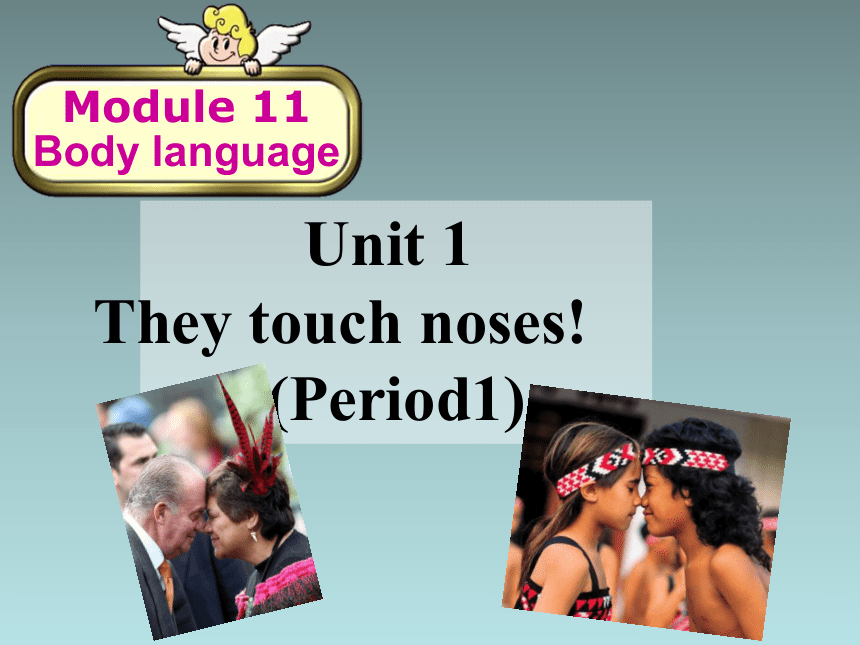 | |
| 格式 | pptx | ||
| 文件大小 | 1.9MB | ||
| 资源类型 | 教案 | ||
| 版本资源 | 外研版 | ||
| 科目 | 英语 | ||
| 更新时间 | 2022-07-10 07:55:04 | ||
图片预览

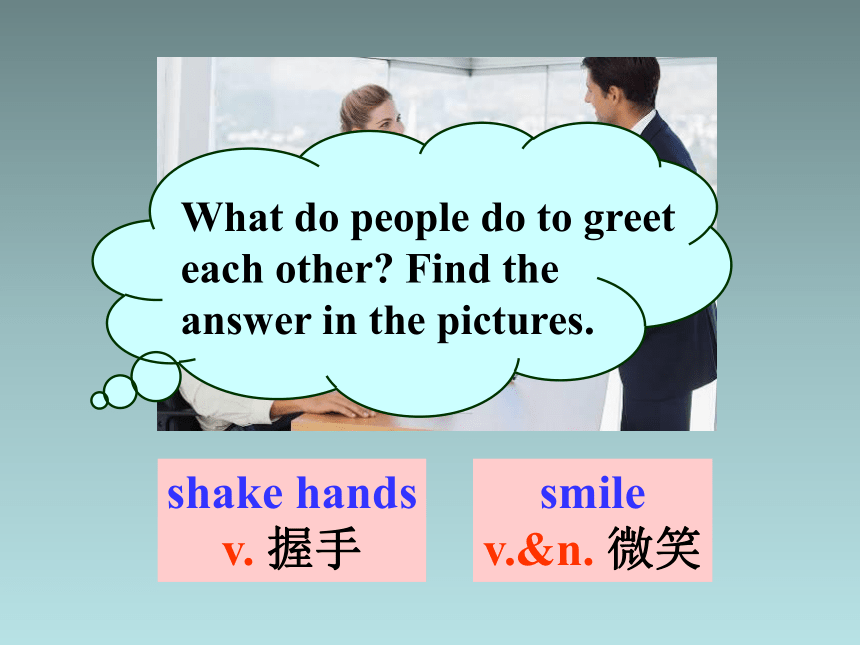
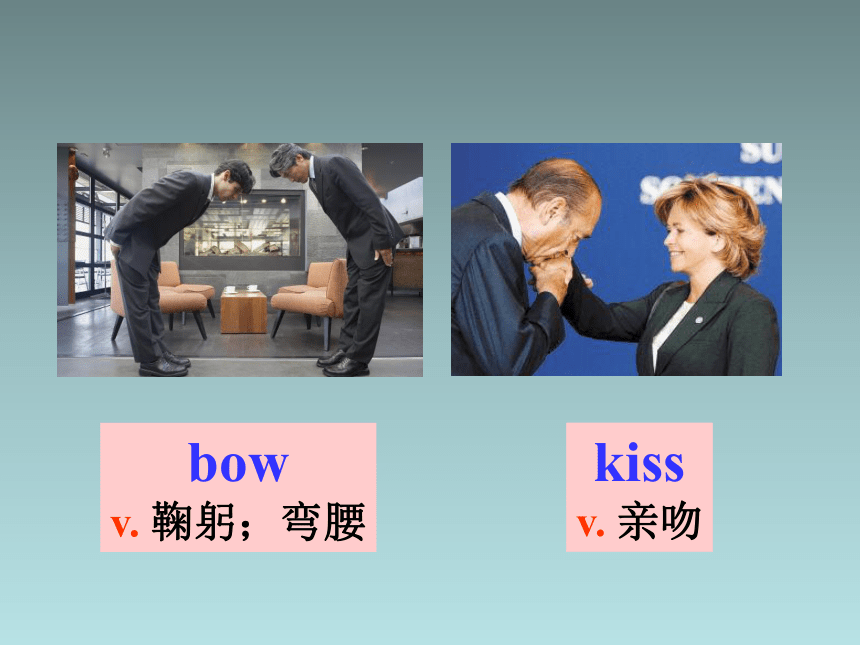
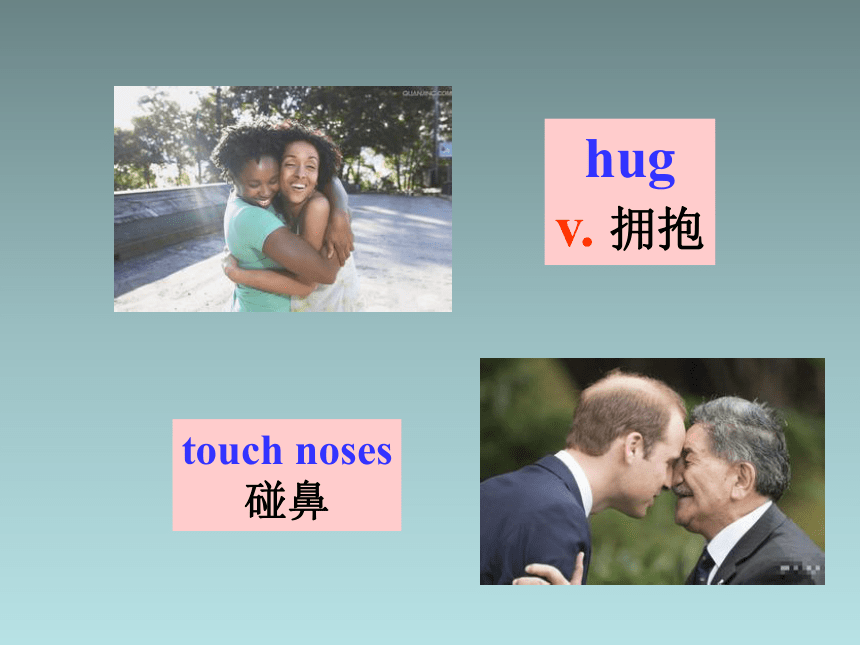

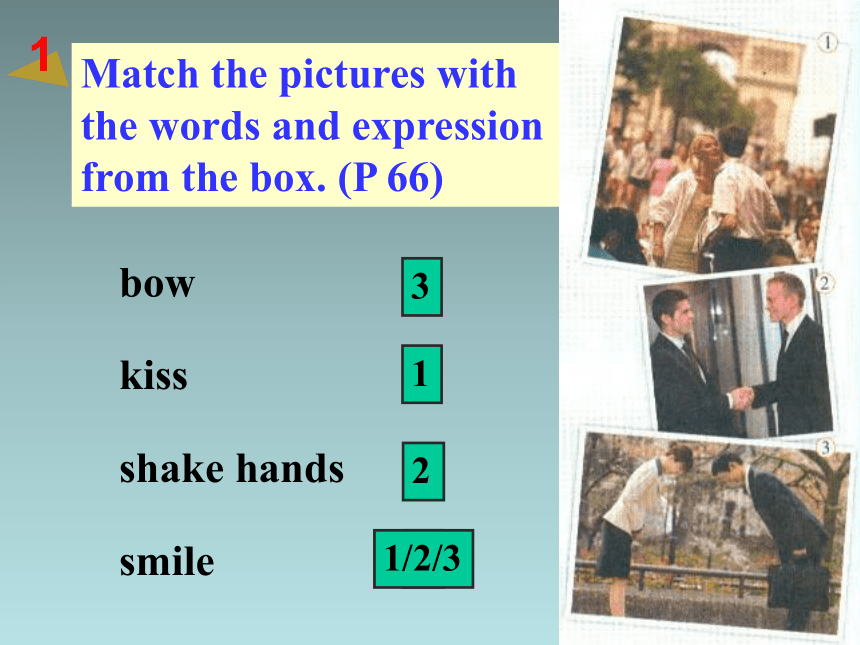
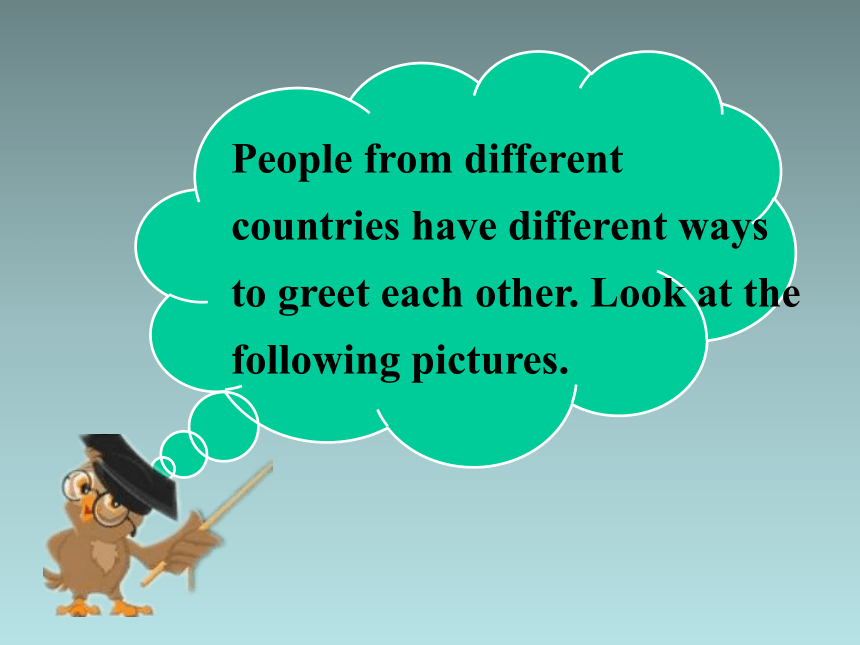
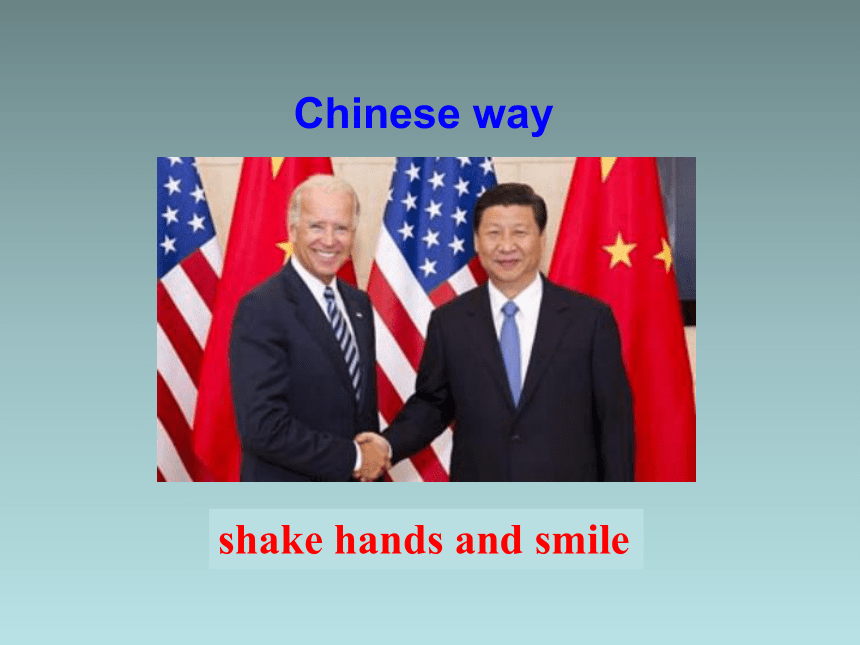
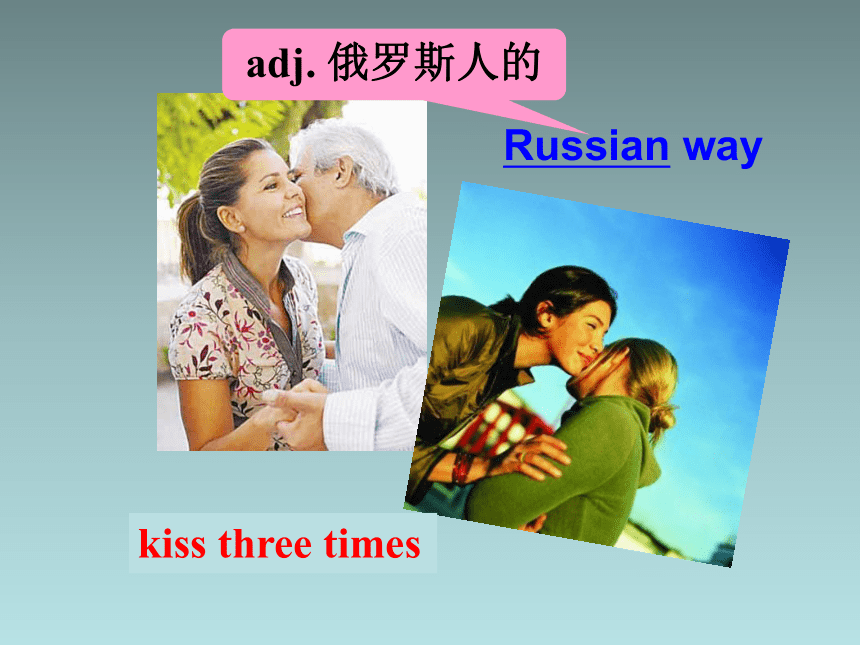
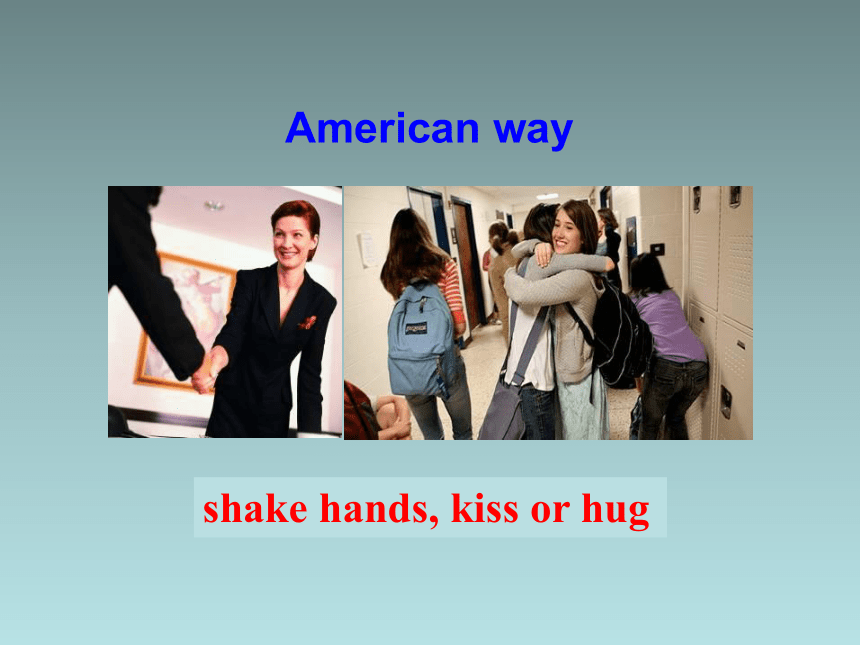
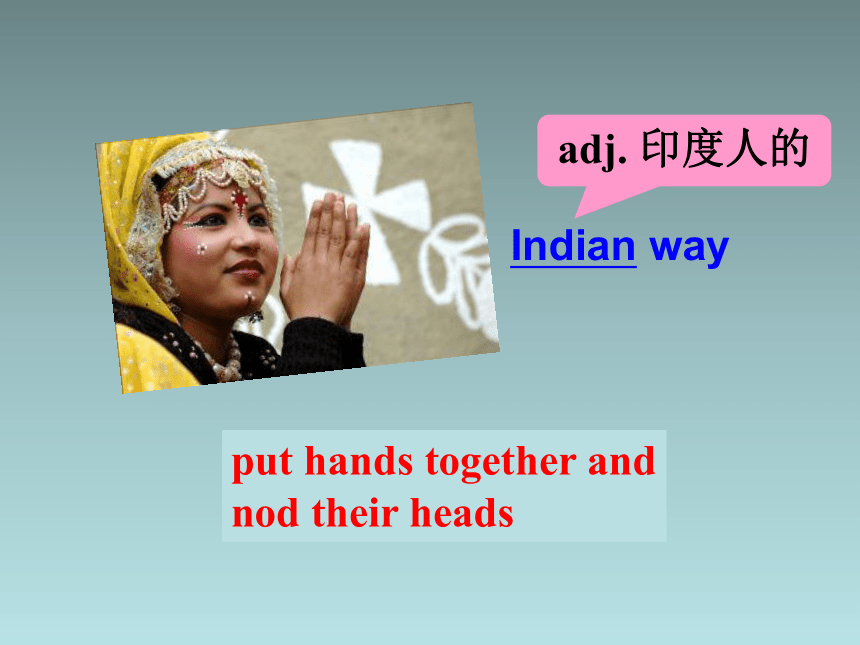
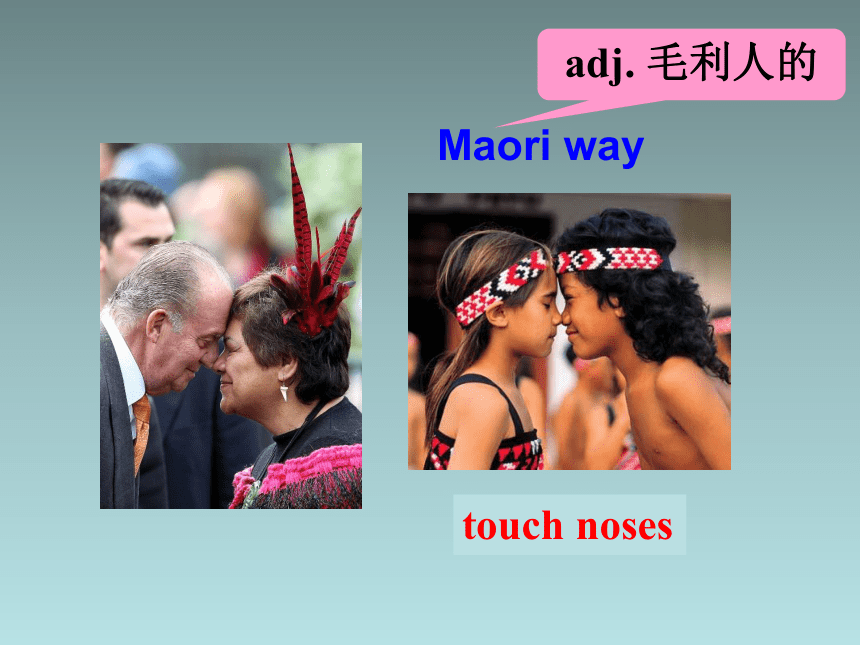
文档简介
(共41张PPT)
Unit 1
They touch noses!
(Period1)
Module 11
Body language
shake hands
v. 握手
smile
v.&n. 微笑
What do people do to greet each other Find the answer in the pictures.
bow
v. 鞠躬;弯腰
kiss
v. 亲吻
hug
v. 拥抱
touch noses
碰鼻
nod one’s head
点头
bow
kiss
shake hands
smile
1
2
3
1/2/3
Match the pictures with the words and expression from the box. (P 66)
1
People from different countries have different ways to greet each other. Look at the following pictures.
Chinese way
shake hands and smile
Russian way
kiss three times
adj. 俄罗斯人的
American way
shake hands, kiss or hug
Indian way
put hands together and nod their heads
adj. 印度人的
Maori way
touch noses
adj. 毛利人的
Japanese way
bow to each other
adj. 日本人的
Listen and match the pictures with the nationality. (P 66)
2
British ( )
French ( )
German ( )
Japanese ( )
Russian ( )
— Are they Russian
— Yes, they are.
— What are they doing
— They’re shaking hands.
Now work in pairs and check.
Tapescript:
Daming: What are they doing
Betty: They are saying hello. They’re kissing.
Daming: Are they German Or English
Betty: Maybe they’re French.
Daming: And these people are shaking
hands. I think they’re Russian.
Betty: I think so too. And these
people are Japanese, I think.
Daming: Why
Betty: Because they’re smiling at
each other and bowing.
Lingling is going to welcome some Russian teachers. How should she do Watch and listen.
Who will come to Lingling’s school
Some Russian teachers.
2. Which country’s people do they talk about in the conversation
Russian, Chinese, American, Indian, and Maori people.
Read the dialogue and then answer the
following questions.
Task 2
3. What do Russian do when they meet
They usually kiss three times, left, right, left.
4. What do Chinese often do when they meet
5. What do people in the US usually do when they meet
6. What do Indians do when they meet
7. What do Maori people do when they meet
Chinese often shake hands and smile when they meet, and sometimes they nod their heads.
In the US some people shake hands, and some kiss or hug each other.
They touch noses.
They put their hands together and nod their heads.
India kiss Russia together touch visitor
Read and complete the table with the correct form of the words from the box. (P 67)
Task 3
3
In China, people shake hands and smile when they meet _____.
American people shake hands and sometimes ______
In ______, people put their hands ___________ and nod their heads
In ______, people kiss each other three times
Maori people _______ noses
India
Russia
visitors
touch
together
kiss
Translate the phrases into English.
each other
nod one’s head
shake hands
put ... together
touch noses
互相,彼此
点头
握手
把......放在一起
碰鼻
Task 4
Unit 1
They touch noses!
(Period2)
Module 11
Body language
In different countries, there are different
ways of greeting (问候) when we meet
visitors. Do you know what they are
Lead in: have a discussion
What are they doing
shake hands
touch noses
What are they doing
bow
put hands together
What are they doing
wave hands
give Hada
1. shake hands 握手
2. nod one’s head 点头
3. hug each other 互相拥抱
4. touch noses 触摸鼻子
5. kiss each other 互相亲吻
6. smile at sb. 冲某人微笑
laugh at sb. 嘲笑某人
Language Points
The mother kissed the sleeping baby on his head.
He threw me a kiss and went away.
Language points
1. … in Russia, people usually kiss three times, left, right, left.
……在俄罗斯,人们通常亲吻面颊三次:左、右、左。
(1) kiss 在本句中为动词,意为“吻,亲 吻”。kiss 也可作名词,意为“吻”。
My mother goes shopping once a week.
— How many times have you been to China
— Six or seven times.
(2) “times”在这里表示次数,“three times”是三次。
在英文中,一次是“once”,两次是“twice”,三次以上都用“…times”。
2. We Chinese often shake hands and smile when we meet visitors.
我们中国人见到来访者的时候经常握手、微笑。
表示“某国人”的名词,单数变复数有以下几种情况:
Ⅰ. 大多数表示“某国人”的名词变复数,符合一般名词的复数变化规律,词尾直接加-s。如:Americans, Russians等。
Ⅱ. 词尾若为-ese,其单复数同形。如:Chinese和Japanese。
Ⅲ. 以-man结尾的复数“某国人”,应将man改为men,如:Englishmen, Frenchmen。
但German除外,应直接加-s,即Germans。
shake v. 摇晃;震动
shake hands 意为“握手”,注意hand要用复数形式。
shake hands with … “和……握手”
He shook his head in disapproval.
His voice shook with fear.
I introduced my new pen friend to Jack
and they shook hands.
Mr. Black shook hands with Mrs. Smith
when they met.
图片中,中国国家主席习近平
和美国总统奥巴马在握手。
In the picture, Chinese President Xi Jinping is ________ _______ _______ American President Obama.
Practise
shaking hands with
3. That’s because people do different things in different countries.
那是因为不同国家的人们做法不同。
“that’s because …”表示 “那是因为……”,后面的句子要用陈述语序。
Practise
那是因为你不够仔细。
That’s because you were not careful enough.
4
Listen and repeat. (P 67)
/t / Chinese, each, French,
teacher, touch
/ / British, shake
/pl/ people
/fr/ French
/br/ British
Now say the words aloud.
5
Work in groups. Talk about what you do and say when you meet: (P 67)
your teacher
your head teacher
your parents after
school
your best friend
your best friend’s
parents
your favourite film star
a visitor to your school
an American
a Russian
— What do you do and say when you
meet your teacher in the morning
— I smile and say good morning.
Ⅰ. Work in groups. Ask and answer.
Ⅱ. Do a role-play in pairs and let others guess who you are meeting.
1. It’s very cold. Tony’s _____(鼻子) becomes red.
2. —Where is your new friend from
—_____ (印度), an Asian country.
3. Don’t _____ (触摸) the dog, Tom! It’s
dangerous!
4. There is always a big ______ (微笑) on my teacher’s face.
5. Mrs. Black ______ (亲吻) her son and then left home.
nose
India
touch
smile
kissed
Ⅰ. 根据提示,写出正确的单词。
1. 他们在队伍中互相帮助。
They help _____ _____ in the team.
2. 谈话前,李奇喜欢和朋友握手。
Li Qi likes to ______ ______ with friends before they talk.
3. 那是因为你今天早晨晚起床的原因。
_______ ________ you got up late this morning.
4. 请把那些红苹果放在一起。
Please ____ the red apples ________.
5. 他们见面时经常点头。
They often ____ _____ ______ when they meet.
each
other
shake
hands
That’s
because
put
together
nod
their
heads
II. 根据汉语提示完成句子,每空一词。
Homework
Ask and answer questions about different body language in different countries we’ve learnt today.
2. Finish the exercises in Learning English.
Unit 1
They touch noses!
(Period1)
Module 11
Body language
shake hands
v. 握手
smile
v.&n. 微笑
What do people do to greet each other Find the answer in the pictures.
bow
v. 鞠躬;弯腰
kiss
v. 亲吻
hug
v. 拥抱
touch noses
碰鼻
nod one’s head
点头
bow
kiss
shake hands
smile
1
2
3
1/2/3
Match the pictures with the words and expression from the box. (P 66)
1
People from different countries have different ways to greet each other. Look at the following pictures.
Chinese way
shake hands and smile
Russian way
kiss three times
adj. 俄罗斯人的
American way
shake hands, kiss or hug
Indian way
put hands together and nod their heads
adj. 印度人的
Maori way
touch noses
adj. 毛利人的
Japanese way
bow to each other
adj. 日本人的
Listen and match the pictures with the nationality. (P 66)
2
British ( )
French ( )
German ( )
Japanese ( )
Russian ( )
— Are they Russian
— Yes, they are.
— What are they doing
— They’re shaking hands.
Now work in pairs and check.
Tapescript:
Daming: What are they doing
Betty: They are saying hello. They’re kissing.
Daming: Are they German Or English
Betty: Maybe they’re French.
Daming: And these people are shaking
hands. I think they’re Russian.
Betty: I think so too. And these
people are Japanese, I think.
Daming: Why
Betty: Because they’re smiling at
each other and bowing.
Lingling is going to welcome some Russian teachers. How should she do Watch and listen.
Who will come to Lingling’s school
Some Russian teachers.
2. Which country’s people do they talk about in the conversation
Russian, Chinese, American, Indian, and Maori people.
Read the dialogue and then answer the
following questions.
Task 2
3. What do Russian do when they meet
They usually kiss three times, left, right, left.
4. What do Chinese often do when they meet
5. What do people in the US usually do when they meet
6. What do Indians do when they meet
7. What do Maori people do when they meet
Chinese often shake hands and smile when they meet, and sometimes they nod their heads.
In the US some people shake hands, and some kiss or hug each other.
They touch noses.
They put their hands together and nod their heads.
India kiss Russia together touch visitor
Read and complete the table with the correct form of the words from the box. (P 67)
Task 3
3
In China, people shake hands and smile when they meet _____.
American people shake hands and sometimes ______
In ______, people put their hands ___________ and nod their heads
In ______, people kiss each other three times
Maori people _______ noses
India
Russia
visitors
touch
together
kiss
Translate the phrases into English.
each other
nod one’s head
shake hands
put ... together
touch noses
互相,彼此
点头
握手
把......放在一起
碰鼻
Task 4
Unit 1
They touch noses!
(Period2)
Module 11
Body language
In different countries, there are different
ways of greeting (问候) when we meet
visitors. Do you know what they are
Lead in: have a discussion
What are they doing
shake hands
touch noses
What are they doing
bow
put hands together
What are they doing
wave hands
give Hada
1. shake hands 握手
2. nod one’s head 点头
3. hug each other 互相拥抱
4. touch noses 触摸鼻子
5. kiss each other 互相亲吻
6. smile at sb. 冲某人微笑
laugh at sb. 嘲笑某人
Language Points
The mother kissed the sleeping baby on his head.
He threw me a kiss and went away.
Language points
1. … in Russia, people usually kiss three times, left, right, left.
……在俄罗斯,人们通常亲吻面颊三次:左、右、左。
(1) kiss 在本句中为动词,意为“吻,亲 吻”。kiss 也可作名词,意为“吻”。
My mother goes shopping once a week.
— How many times have you been to China
— Six or seven times.
(2) “times”在这里表示次数,“three times”是三次。
在英文中,一次是“once”,两次是“twice”,三次以上都用“…times”。
2. We Chinese often shake hands and smile when we meet visitors.
我们中国人见到来访者的时候经常握手、微笑。
表示“某国人”的名词,单数变复数有以下几种情况:
Ⅰ. 大多数表示“某国人”的名词变复数,符合一般名词的复数变化规律,词尾直接加-s。如:Americans, Russians等。
Ⅱ. 词尾若为-ese,其单复数同形。如:Chinese和Japanese。
Ⅲ. 以-man结尾的复数“某国人”,应将man改为men,如:Englishmen, Frenchmen。
但German除外,应直接加-s,即Germans。
shake v. 摇晃;震动
shake hands 意为“握手”,注意hand要用复数形式。
shake hands with … “和……握手”
He shook his head in disapproval.
His voice shook with fear.
I introduced my new pen friend to Jack
and they shook hands.
Mr. Black shook hands with Mrs. Smith
when they met.
图片中,中国国家主席习近平
和美国总统奥巴马在握手。
In the picture, Chinese President Xi Jinping is ________ _______ _______ American President Obama.
Practise
shaking hands with
3. That’s because people do different things in different countries.
那是因为不同国家的人们做法不同。
“that’s because …”表示 “那是因为……”,后面的句子要用陈述语序。
Practise
那是因为你不够仔细。
That’s because you were not careful enough.
4
Listen and repeat. (P 67)
/t / Chinese, each, French,
teacher, touch
/ / British, shake
/pl/ people
/fr/ French
/br/ British
Now say the words aloud.
5
Work in groups. Talk about what you do and say when you meet: (P 67)
your teacher
your head teacher
your parents after
school
your best friend
your best friend’s
parents
your favourite film star
a visitor to your school
an American
a Russian
— What do you do and say when you
meet your teacher in the morning
— I smile and say good morning.
Ⅰ. Work in groups. Ask and answer.
Ⅱ. Do a role-play in pairs and let others guess who you are meeting.
1. It’s very cold. Tony’s _____(鼻子) becomes red.
2. —Where is your new friend from
—_____ (印度), an Asian country.
3. Don’t _____ (触摸) the dog, Tom! It’s
dangerous!
4. There is always a big ______ (微笑) on my teacher’s face.
5. Mrs. Black ______ (亲吻) her son and then left home.
nose
India
touch
smile
kissed
Ⅰ. 根据提示,写出正确的单词。
1. 他们在队伍中互相帮助。
They help _____ _____ in the team.
2. 谈话前,李奇喜欢和朋友握手。
Li Qi likes to ______ ______ with friends before they talk.
3. 那是因为你今天早晨晚起床的原因。
_______ ________ you got up late this morning.
4. 请把那些红苹果放在一起。
Please ____ the red apples ________.
5. 他们见面时经常点头。
They often ____ _____ ______ when they meet.
each
other
shake
hands
That’s
because
put
together
nod
their
heads
II. 根据汉语提示完成句子,每空一词。
Homework
Ask and answer questions about different body language in different countries we’ve learnt today.
2. Finish the exercises in Learning English.
同课章节目录
- Module 1 Lost and found
- Unit 1 Whose bag is this?
- Unit 2 Are they yours?
- Unit 3 Language in use
- Module 2 What can you do ?
- Unit 1 I can play the piano
- Unit 2 I can run really fast
- Unit 3 Language in use
- Module 3 Making plans
- Unit 1 What are you going to do at the weekends?
- Unit 2 We're going to cheer the players.
- Unit 3 Language in use
- Module 4 Life in the future
- Unit 1 Everyone will study at home
- Unit 2 Every family will have a small plane.
- Unit 3 Language in use
- Module 5 Shopping
- Unit 1 What can I do for you?
- Unit 2 You can buy everything on the Internet
- Unit 3 Language in use
- Module 6 Around town
- Unit 1 Could you tell me how to get to the Nationa
- Unit 2 The London Eye is on your right.
- Unit 3 Language in use
- Revision module A
- Module 7 My past life
- Unit 1 I was born in a small village.
- Unit 2 I was born in Quincy.
- Unit 3 Language in use
- Module 8 Story time
- Unit 1 Once upon a time….
- Unit 2 Goldilocks hurried out of the house.
- Unit 3 Language in use
- Module 9 Life history
- Unit 1 He left school and began work at the age of
- Unit 2 He decided to be an actor.
- Unit 3 Language in use
- Module 10 A holiday journey
- Unit 1 What did you do?
- Unit 2 This morning we took a walk.
- Unit 3 Language in use
- Module 11 Body language
- Unit 1 They touch noses!
- Unit 2 Here are some ways to welcome them.
- Unit 3 Language in use
- Module 12 Western music
- Unit 1 It's so beautiful!
- Unit 2 Vienna is the centre of European classical
- Unit 3 Language in use
- Revision module B
